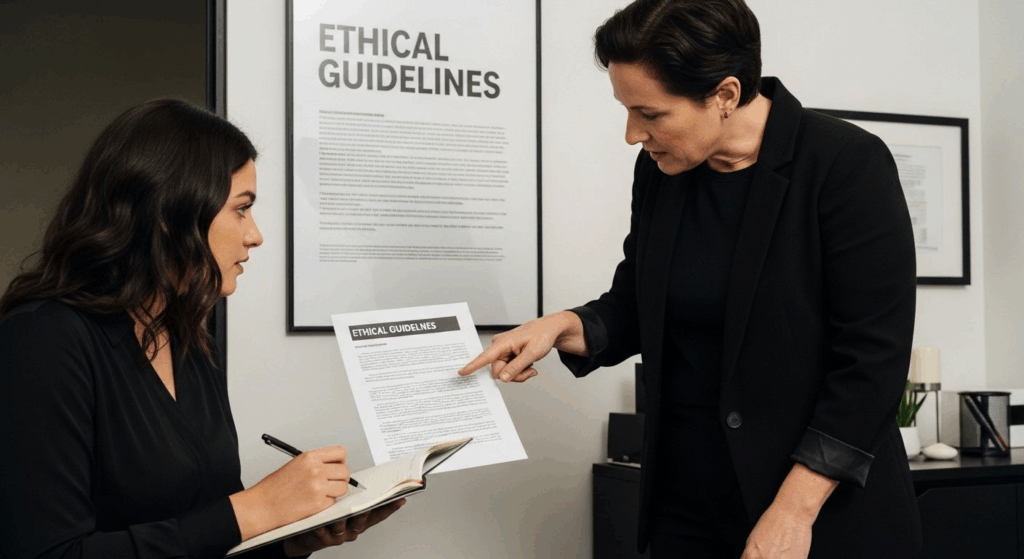
News writing shapes the way people see the world and keeps society informed about what matters most. But even seasoned journalists can fall into traps that damage credibility and trust. Just one unverified detail can shatter a reporter’s career and ruin a news outlet’s reputation. The real secret is not just telling stories but mastering strict standards that separate true professionals from the rest.
Table of Contents
- Key Features Of News Writing
- Steps To Draft An Effective News Story
- Common Mistakes And How To Avoid Them
- Ethical Guidelines In News Writing
Quick Summary
| Takeaway | Explanation |
|---|---|
| Understand newsworthiness for impactful stories | Evaluate stories based on timeliness, relevance, and audience impact to engage readers effectively. |
| Master the ‘5 Ws and H’ of news writing | Cover Who, What, Where, When, Why, and How to ensure comprehensive story coverage and reader understanding. |
| Emphasize fact-checking to maintain credibility | Cross-verify information from multiple sources to ensure accuracy and avoid damaging errors in your reporting. |
| Adhere to ethical guidelines for responsible journalism | Uphold truth, transparency, and minimize harm to maintain trust and integrity in your reporting practices. |
| Craft clear, engaging narratives | Organize information effectively and use straightforward language to capture and maintain reader interest throughout your story. |
Key Features of News Writing
News writing is a specialized form of communication that demands precision, clarity, and a deep understanding of storytelling fundamentals. Mastering the key features of news writing transforms raw information into compelling narratives that capture readers’ attention and deliver critical insights.
The Essence of Newsworthiness
Understanding newsworthiness is crucial for journalists seeking to create impactful stories. According to the University of Florida’s Institute of Food and Agricultural Sciences, several critical elements determine a story’s relevance and appeal. These include timeliness, proximity, prominence, significance, human interest, innovation, conflict, and financial impact.
To help readers quickly understand what determines newsworthiness, here is a summary table of the key elements mentioned:
| Element | Description |
|---|---|
| Timeliness | Is the story happening now or recently occurred? |
| Proximity | Is the event relevant to the audience’s location? |
| Prominence | Does it involve notable people or institutions? |
| Significance | Does it impact a large number of people? |
| Human Interest | Does it evoke emotions or provoke conversation? |
| Innovation | Is there something new or breakthrough involved? |
| Conflict | Is there a clash, controversy, or struggle present? |
| Financial Impact | Does it affect finances, business, or the economy? |
Reporters must evaluate stories through multiple lenses. A newsworthy piece typically answers fundamental questions: Does the story matter to the audience? Will it provoke emotion or spark conversation? Is it happening now or has immediate relevance?
Structural Integrity of News Writing
The structural framework of news writing relies on the comprehensive ‘5 Ws and H’ approach. As DePaul University’s Writing Center highlights, this method ensures journalists cover Who, What, Where, When, Why, and How in their reporting. This systematic approach guarantees that readers receive a complete understanding of the story.
Key structural components include:
- Accuracy: Presenting factual information without bias
- Clarity: Using straightforward language
- Objectivity: Reporting events without personal interpretation
- Conciseness: Delivering information efficiently
Storytelling with Precision
Southern Nazarene University emphasizes that exceptional news writing transcends mere information delivery. It requires crafting stories that possess relevance, timeliness, balance, and human interest. Successful journalists weave facts into narratives that resonate with readers, transforming statistical information into meaningful experiences.
This approach demands rigorous research, critical thinking, and the ability to distill complex information into digestible, engaging content. Journalists must remain committed to truth, fairness, and the core principle of informing the public responsibly.
By understanding and implementing these key features, writers can create news stories that not only inform but also connect with readers on a deeper level, bridging gaps in understanding and fostering meaningful communication.
Steps to Draft an Effective News Story
Crafting an effective news story requires a systematic approach that transforms raw information into a compelling narrative. Journalists must navigate complex steps to ensure their reporting is accurate, engaging, and meaningful.
Initial Research and Information Gathering
The foundation of any strong news story lies in thorough research and fact collection. Purdue University’s Online Writing Lab emphasizes the critical importance of gathering comprehensive and credible information before drafting.
Successful research involves multiple strategies:
- Source Verification: Cross-checking information from multiple reliable sources
- Background Investigation: Understanding the context of the story
- Expert Consultation: Seeking insights from professionals related to the topic
Journalists must remain vigilant about potential biases and ensure they collect information from diverse and reputable sources. This preliminary work establishes the credibility and depth of the eventual news story.
Structuring the Story
Once information is gathered, the next crucial step involves organizing the narrative. The inverted pyramid structure remains a cornerstone of news writing, where the most critical information appears first, followed by supporting details.
Key structural elements include:
- Strong Lead: Capturing the core of the story in the first paragraph
- Supporting Details: Providing context and additional information
- Background Information: Offering historical or supplementary insights
This approach ensures readers understand the most important aspects of the story immediately, allowing them to continue reading for deeper understanding or stop with the essential information.
Refinement and Editing
The final stage of drafting a news story involves meticulous review and editing. Journalists must critically examine their work for accuracy, clarity, and narrative flow. This process goes beyond simple grammar checking and requires a comprehensive evaluation of the story’s integrity.
Effective editing involves:
- Removing unnecessary jargon
- Ensuring factual accuracy
- Maintaining objective tone
- Checking source credibility
- Verifying all quotes and statistics
By following these systematic steps, journalists transform raw information into powerful, informative narratives that engage readers and communicate complex ideas with precision and clarity. The art of news writing lies not just in reporting facts, but in presenting them in a manner that resonates with and enlightens the audience.
The following table breaks down the main steps for drafting an effective news story, along with their main tasks, summarized for easy reference:
| Step | Key Tasks |
|---|---|
| Initial Research & Information Gathering | Source verification, background investigation, expert consultation |
| Structuring the Story | Write strong lead, add supporting details, include background information |
| Refinement and Editing | Remove jargon, check accuracy, maintain tone, verify sources and quotes |
Common Mistakes and How to Avoid Them
News writing demands precision and professionalism. Even experienced journalists can fall into predictable traps that compromise the quality and credibility of their reporting. Understanding and addressing these common mistakes is crucial for maintaining high journalistic standards.
Bias and Objectivity Pitfalls
Maintaining objectivity is a fundamental challenge in news writing. Reuters Institute for the Study of Journalism highlights that unconscious bias can significantly distort reporting, even when journalists believe they are being neutral.
Common bias-related mistakes include:
- Personal Perspective Intrusion: Allowing personal opinions to color reporting
- Selective Source Inclusion: Choosing sources that only confirm preexisting views
- Language Framing: Using loaded words that suggest a particular interpretation
To combat bias, journalists must actively seek diverse perspectives, challenge their own assumptions, and present balanced narratives that represent multiple viewpoints fairly.
Factual Errors and Verification Challenges
The Poynter Institute emphasizes that factual accuracy is the cornerstone of credible journalism. Simple mistakes can destroy a journalist’s reputation and undermine the entire story.
Critical verification strategies include:
- Multiple Source Confirmation: Cross-referencing information from different reliable sources
- Direct Quote Verification: Confirming exact wording with original sources
- Fact-Checking Protocols: Implementing rigorous pre-publication review processes
Journalists must develop a systematic approach to fact-checking, treating every piece of information with healthy skepticism and requiring substantive evidence before publication.
Structural and Narrative Weaknesses
Poor story structure can render even the most important information ineffective. Journalists often struggle with creating clear, engaging narratives that capture and maintain reader attention.
Common structural mistakes include:
- Burying Critical Information: Hiding key details deep in the story
- Excessive Technical Language: Using jargon that alienates readers
- Lack of Clear Context: Failing to provide sufficient background information
Successful news writing requires a delicate balance between comprehensive reporting and accessible storytelling. Journalists must learn to distill complex information into clear, compelling narratives that inform and engage readers.
By recognizing and proactively addressing these common mistakes, journalists can elevate their craft, maintain professional integrity, and deliver news stories that are both accurate and meaningful. The most respected news writers are those who combine technical skill with a commitment to truth and clarity.
Ethical Guidelines in News Writing
Ethics form the cornerstone of responsible journalism, providing a moral compass that guides reporters through complex reporting landscapes. Maintaining high ethical standards is not just a professional requirement but a fundamental responsibility to the public trust.
Principles of Journalistic Integrity
Society of Professional Journalists outlines core ethical principles that define responsible news writing. These principles emphasize the paramount importance of truth, accuracy, independence, and accountability in reporting.
Key ethical principles include:
- Truthfulness: Reporting facts without distortion
- Transparency: Revealing sources and methods when possible
- Minimizing Harm: Protecting individuals’ rights and dignity
- Independence: Avoiding conflicts of interest
Journalists must continually evaluate their work through an ethical lens, understanding that their reporting can significantly impact individuals, communities, and public discourse.
Protecting Source Confidentiality
The Reporters Committee for Freedom of the Press highlights the critical importance of source protection. Journalists often encounter situations where maintaining source confidentiality becomes a complex ethical challenge.
Ethical source management involves:
- Establishing Clear Agreements: Defining confidentiality terms upfront
- Protecting Vulnerable Sources: Shielding individuals from potential retaliation
- Balancing Public Interest: Weighing confidentiality against significant public information
Reporters must develop robust protocols for protecting sources while maintaining journalistic integrity. This requires careful negotiation, clear communication, and a deep commitment to ethical principles.
Navigating Sensitive Reporting Scenarios
Reporting on sensitive topics demands extraordinary ethical consideration. Journalists must balance the public’s right to know with individual privacy, potential harm, and broader societal implications.
Critical ethical considerations include:
- Consent: Obtaining appropriate permissions for interviews and stories
- Representation: Ensuring fair and respectful portrayal of individuals and communities
- Contextual Reporting: Providing comprehensive understanding beyond sensationalism
Reporters must approach sensitive stories with empathy, nuance, and a commitment to truth that goes beyond mere factual reporting. This means understanding the human impact of their work and making deliberate choices that respect individual dignity.
Ethical news writing is not about following a rigid set of rules but cultivating a deep sense of professional responsibility. Journalists serve as critical intermediaries between events and public understanding, carrying an immense responsibility to report truthfully, fairly, and with genuine human compassion.
By adhering to robust ethical guidelines, news writers can maintain the credibility of journalism as a vital democratic institution. The most respected journalists are those who demonstrate unwavering commitment to truth, fairness, and the broader public interest.

Frequently Asked Questions
What are the key elements of newsworthiness?
The key elements of newsworthiness include timeliness, proximity, prominence, significance, human interest, innovation, conflict, and financial impact. These factors help journalists determine the relevance and appeal of a story to their audience.
How do I structure a news story effectively?
A well-structured news story typically utilizes the inverted pyramid format, where the most critical information is presented first, followed by supporting details and background information. This ensures that readers can quickly grasp the essential points of the story.
What steps should I follow to draft a compelling news article?
To draft a compelling news article, follow these steps: conduct initial research and information gathering, structure the story with a strong lead and supporting details, and refine the article through meticulous editing for clarity and accuracy.
How can I avoid common biases in my news writing?
To avoid common biases, actively seek diverse perspectives, challenge your assumptions, and strive to present a balanced narrative. Additionally, be mindful of language that may imply bias, and prioritize objective reporting throughout your writing.
Elevate Your News Writing With Trusted Resources
Are you struggling to meet the strict demands of news writing—like mastering objectivity, accuracy, and the proven techniques outlined in our guide? Missing just one fact or letting bias sneak into your articles can quickly erode reader trust. If you want to build lasting credibility and stay ahead in the fast-paced world of journalism, you need a source you can rely on every day.

Access Ultra News for expertly curated guides, up-to-date journalism trends, and real examples of engaging stories. Explore our Education section for actionable tips and walk away with the confidence to refine your reporting skills. Start browsing now so you never miss a newswriting insight that could shape your career.




